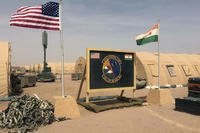The U.S. Air Force plans to apply a new acquisition strategy to a handful of weapons programs, from a new trainer aircraft to a battlefield intelligence system, the service's top civilian said.
Air Force Secretary Deborah Lee James announced the effort, dubbed "Bending the Cost Curve," on Wednesday at the Atlantic Council. The idea is for the service to work with defense contractors to encourage innovation, cut costs and speed up the acquisition process, she said.
James, a former executive at SAIC Inc. and onetime staffer on Capitol Hill, said it takes the Air Force, on average, 17 months -- almost a year and a half -- to award a sole-source contract. "That is simply too long," she said.
The new strategy is more targeted than the Pentagon's Better Buying Power effort, the secretary said, and includes three components: enhancing interaction with companies, expanding competition to include non-traditional contractors, and improving internal business analytics.
The first component includes launching a so-called Cost Capability Analysis to better identify instances where small changes in requirements have a large impact on cost, James said. For example, if the service has a requirement for a jet to fly 500 miles per hour, but could save a significant amount of money by reducing the figure to 450 miles per hour, officials could use the information to make trade-offs, she said.
The Air Force plans to apply the analysis to a handful of acquisition programs, including the T-X jet trainer, Long-Range Stand-off Weapon, Multi-Adaptive Prodded System and Space-Based Infrared System follow-on, the secretary said.
The second strategy component will make it easier for the Air Force to award contracts after events where company officials demonstrate their products to government customers, James said. The first such industry event, known as PlugFest Plus, will take place Jan. 20 at George Mason University in Fairfax, Virginia, and apply to the Distributed Common Ground System, an open-source intelligence system that collects data from a variety of sensors, she said.
"If this event proves successful, we will take steps to evolve the process to other Air Force applications," she said.
The third component of the strategy seeks to set up a business analytics office for information technology, James said. It was the No. 1 recommendation from corporate chief information officers who were asked about what could be done to bring down the service's acquisition costs, she said.
"What we're really after here is a data-driven approach to spending," she said, noting that similar efforts in the private sector have reduced costs by 25 percent or more.








